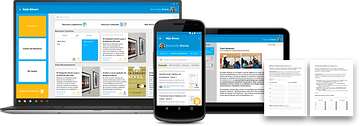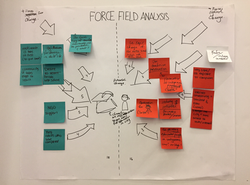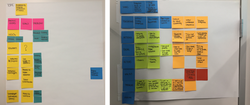Throughout my career, I’ve designed and collaborated with Ford Motor Company, IDEO CoLab, Lucid Motors, The Art of Living Foundation, LIM Innovations, Fundación Tarahumara José A. Llaguno; currently volunteering at Inneract Project.
I’m currently looking for opportunities in Social Impact Design. If your team strives to work with organizations to help build ethically responsible solutions with communities through design strategy, I’d love to collaborate with you.
An Interaction Designer, Design Researcher, and Strategist.
An Interaction Designer, Design Researcher, and Strategist.

As part of my senior thesis project, I created Nejé Béneri. An educational online and offline cross-platform for teachers who work with indigenous communities in Mexico, providing access to cultural and linguistic resources, and enabling educators to build their own teacher-to-teacher knowledge hub.
Role and Approach
I went through a meticulous problem discovery phase, two rigorous research and iteration phases that led to prototyping and on-the-field user-testing with teachers.
Tools
Sketch, Adobe Illustrator, Photoshop & Premiere, InVision, Keynote.
Project Motivation
Being from Mexico and having had access to education, in part due to being mestizo (of half Spanish and half indigenous decent), I wanted to use my privilege and my interaction design skills to empower Mexican indigenous youth achieve success.
Instructors
Length
8 (nonconsecutive) months
A massive underlying problem.
Out of the 15.7 million indigenous people living in Mexico, 80% of them live under poverty or extreme poverty.
Indigenous people are the most marginalized, underrepresented, and under-resourced group in Mexico.
The Mexican education system
serving indigenous communities is broken.

Out of the 2 million indigenous kids who start with primary education, only 4,252 graduate from high school.
The Mexican Secretary of Public Education created the National Teacher Professional Service. An online platform aimed at standardizing evaluation methods to assess the skills and abilities of those who aspire to become public teachers and to improve the methods to evaluate teacher performance.

Key Problem
Teachers are limited by deficient training that ignores the cultural and social dynamics of the indigenous communities they work with.
How might we help educate the educator?
Introducing
(Translating to “I Teach”, in the indigenous Raramuri language)
An educational online and offline cross-platform for teachers who work with indigenous communities, providing access to cultural and linguistic resources while building a teacher-to-teacher knowledge hub.

My Process

I covered every aspect of the design process, from research to ideation to prototyping. I used IDEO’s design thinking methodology as a basis for my process.
Discovery
 |  |
|---|---|
 |  |
 |  |
As seniors, we were given the liberty to focus our thesis on any topic we deemed would create value. I knew from the beginning that I wanted to tackle and contribute to bettering an issue of my home country, Mexico.
It was challenging at first to wrap my head around the large, yet opportunity-rich problems I was passionate about. In order to identify a topic area of interest with an opportunity for change that I could realistically approach through interaction design, I conducted many individual and team ideation exercises; such as affinity and 4x4 mapping, force field analysis and journey mapping.
I also conducted Secondary Research at the beginning of the project to give me background and context on the topics before the primary research I’d do later on.
Who I talked to • Primary Research

Misha Abbas
Winner of 2017 CCA Impact Awards - Worked with Textile communities at Karachi, Pakistan

José Brunner
Border Phenomena, Diversity Studies Lecturer at CCA


Mariel Ramírez
Operational Director at Tarahumara Foundation Jose A. Llaguno

Martha Garza
Director at Centro de Acopio para la Tarahumara, A.C.

Kimberly Shuck
Indigeneities, Diversity Studies Lecturer at CCA
I interviewed six individuals who had experience with and/or a perspective on indigenous peoples and the difficulties they face.
From my interviews I met Mariel, the director of Fundación Tarahumara José A. Llaguno. This NGO became a key partner in helping me conduct primary research with my users later on in my project by acting as the bridge between an indigenous community and I.
Interpretation
What I learned • Insights
1. There is value in a singular community.
There is value on focusing within a specific demographic and group of people given that each community is unique and diverse. There is an opportunity to focus on a specific Indigenous community, which will bring value specific to the them.
2. Giving back to own community.
There is an opportunity for Indigenous Tarahumara youth to give back to their community through giving them access to education, increasing the chances of them making a lasting change in their own community.
4. Offline technology access.
Inaccessibility to the internet hinders educational teaching and learning potential. Therefore, there is an opportunity to improve teaching and learning practices through offline technology access.
3. Specific learning tools for a specific community.
Inaccessibility to proper learning tools from an early age specific to the Tarahumara communities leads to high Illiteracy rates, therefore there is an opportunity to improve teaching and learning practices that are unique to the community through access to internet educational platforms.
5. Privilege as a tool for change.
By, 1) Identifying the root causes vs symptoms of the problem, 2) identifying one’s own privilege, and 3) working directly with the community rather than speaking for them, it would lead to an opportunity for a more empathetic dialogue with the community (using the NGO as a bridge), that would contribute to a way of measuring impact and success at the end.
Opportunities

Value Proposition
To develop a system that improves teaching and/or learning opportunities will help Indigenous teenagers who want to want to pursue higher education and give back to their communities by providing access to offline technology platforms that are unique to the indigenous Tarahumara needs.
Ideation




In order to generate ideas on the insights and opportunities I identified, I storyboarded, system mapped, created product molecules (people, problem, solution) and visually represented the opportunity spaces.
Meeting my user
Over winter break I traveled to Mexico with the purpose of meeting with my NGO partner and conducting ethnographic research at schools. Through the brainstorming session I facilitated to my NGO partner and the ethnographic research conducted, I gained deeper insights on my users, the problem space, and potential solutions.


I chose Optimizing Teaching because...
A student’s education cycle starts with the teacher. The teaching methodology that's used is key for rooting an impulse for change and contribution to one’s community.
SPRINT 5
- Final Design Presentation

Narrowing down the problem
As I moved from ideation to prototyping, I struggled in simplifying the problem space in optimizing teaching and how I could ethically, yet effectively intervene.
To help me solve this, I created a matrix of all the opportunity problems, my hypotheses, my proposed solutions, and how success would be measured. I was able to identify and develop three main product features that would go on to the first iteration of prototyping and user-testing.
I would build a platform for...
teachers - online and offline accessible. It would act as a tool to help optimize their teaching.
This tool would simply be an addition to a teacher’s existing ecosystem of tools for knowledge exchange.

Key Insights I took into consideration:
Offline technology access
Inaccessibility to the internet hinders educational teaching and learning potential. Therefore, there is an opportunity to improve teaching and learning practices through offline technology access.
Specific learning and teaching tools for a specific community
Inaccessibility to proper learning tools from an early age specific to the Tarahumara communities leads to high Illiteracy rates, therefore there is an opportunity to improve teaching and learning practices that are unique to the community through access to internet educational platforms.
Experimentation
Prototyping • 1st iteration
1. Mobile app platform


Resources
Understand, connect and empathize with the cultures, practices, and backgrounds
that are unique and specific of the community you work with.

Personal Practices
Reflect and keep track of what you see is working and what isn’t working in your teaching practices for the whole class or for a specific student.

Collaboration
Adjust and make changes to the classroom environment based on reflection you make, which will help lead you to more engaging learning methods and specific needs for your students.
2. Website/desktop platform

3. Platform teacher content
Nejé Béneri’s collaboration feature is dependent on the upload of teacher-created content. Given the lack of teacher-created content at the initial launch of the platform, I created teaching didactic exercises that would serve as initial content. These exercises aided in identifying and creating positive teaching habits in the classroom. The forms where emailed and remotely tested. Results and feedback were collected while in my trip to Mexico.
A/B Testing • InVision



Mobile app

Desktop/website
User testing
Over spring break I traveled back to Mexico to conduct A/B user testing with the teachers I had met during my past ethnographic research trip. I tested a mobile and desktop prototype using InVision, while also collecting the data from the remote user tested platform content.
During user testing I presented four scenarios and use cases, which gave insight on the usefulness and the ease of use of the features I had built for the teacher platform.
Remote user testing

Platform content
Testing Use-cases
• Translate the word "hello" from Spanish to rarámuri on the mobile app, then do the same on the computer
• Find the list of socio-cultural resources that help you understand students’ behavior more.
• Search on Teachers’ Hub "Increasing students performance".
• Create a new exercise called "Raramuri Tutor", and share it with the teacher community.
Insights from testing
• Teachers want to have access to teaching strategies from teachers in other localities.
• Some teachers struggle to engage students when unfamiliar with the students’ culture.
• Some teachers struggle to verbalize lessons when unfamiliar with students’ language.
Evolution
Prototyping • 2nd iteration
Validated. Why?
Resources feature gives teachers access to a library of existing cultural and linguistic resources specific to the indigenous region they teach, such language translators, events, and content from subject matter experts. Currently, there is no central hub for readily available resources on specific indigenous groups.
This feature was kept in the final design iteration.

I do sometimes wish I could speak Raramuri (Tarahumaras people’s language). It’s sometimes challenging to explain a part of a lesson to them when there is no translation for some words from Spanish to Raramuri.
- Brenda, Math Teacher

Resources
Helps you understand, connect and empathize with the cultures, practices, and backgrounds that are unique and specific to the community you work with.
Validated. Why?
Collaboration feature allows for an exchange of teaching strategies among teachers of various localities. Teachers learn new teaching strategies from each other through collective sharing, rather the app presenting definitive strategies that might or might not work for all teachers.
This feature was kept and split into Teachers'
Hub and Hub Contributions in the final design iteration.

We have teacher meetings where we share what works and what does not work for us. However, it would be extremely beneficial for us to see what teachers from other schools and localities are doing. We currently have no way of knowing that.
- José, History Teacher

Collaboration
Helps you adjust and make changes to your classroom by learning from other teachers, which could lead to more engaging teaching methods for your students' needs.
Vetoed. Why?
The Personal Practices feature, which allowed teachers to track their own teaching habits, failed at improving the teaching strategies of most. The feature was a specific solution for the needs of a few.
This feature was removed from the final design iteration and replaced with Teachers' Hub and Hub Contributions, as they allow for solutions for the needs of the many.

Personal Practices
Helps you reflect and keep track of what you see is working and what isn’t working in your teaching practices for the whole class or a specific student
Final Design • InVision



Resources
Provides teachers with existing digital resources on culture and language available online & offline.
Teachers’ Hub
Creates a community of teachers to share and upload their own teaching tools and didactics while also being able to search what other teachers have shared.






Hub Contributions
Teachers can share their own creative teaching practices with the Teachers’ Hub community or save it for their own use.
 | |
|---|---|
 |  |
 |  |
|---|
Platform Accessibility

Material Design
Android mobile phone ownership in emerging economies is rapidly increasing due to a continuous decrease in low-end smart phones costs. Taking this into consideration, I applied Material Design principles into Nejé Béneri rather than iOS to match accessibility needs.
Cross-platform
Material Design stresses the importance of consistency in design across multiple interfaces; this includes layout, visual language, movement and motion, and interactions with affordances.



Connectivity
Connectivity is fundamental for Nejé Béneri to function. Without it the platform looses value. Taking this into consideration, I researched connectivity methods currently in existence or set to be released in the near future. Under the assumption that cellphone connectivity was more accessible than wifi in Mexican rural regions, internet.org, accessible only through 3G connectivity, seemed like the ideal channel for accessing the platform.
However, on-the-field research proved my assumption wrong, and affirmed that wifi usage covers a larger area than 3G connectivity in Mexican rural communities.
This affirmed the importance of on-the-field and ethnographic research.

Next Steps
Rendition of Project Loon contributing to connecting remote communities
The ambitious goal of Nejé Béneri is to become a tool that contributes to incrementing the opportunities for indigenous kids and teenagers to complete high school, move into higher education, and essentially come back to their communities, contributing to their development with their newly acquired skills. Not only does Nejé Béneri have the potential of reaching the whole Tarahumara indigenous population in the state of Chihuahua, but also has the larger potential of expanding to the more than 60 ethnic indigenous groups in Mexico. On the long run, Nejé Béneri could become a large network of knowledge exchange across teachers from different indigenous communities in developing countries.


Through this project I took a very research-heavy approach with the goal truly understanding the problem space I was dealing with, while avoiding a savior complex mentality. This proved out to be successful, as I received astounding validation from the teachers in the community and the my partners from the NGO. However, designing through remote distance from the problem space and its users turned out to be a challenge that limited the amount and variety of user-testing I was be to conduct. In my next steps I would like to include more schools from other communities, as well as including more indigenous people in user-testing - indigenous teachers and indigenous students, as their different perspectives will bring value to the development of the platform.
In the future, Nejé Béneri could implement internet connectivity technology, such a Project Loon, aiming to bring internet connectivity to remote rural areas by launching numerous satellite balloons into the sky, helping expand Nejé Béneri’s teacher-to-teacher knowledge hub community. In order to make Nejé Béneri a reality I will need to continue researching, user-testing and iterating upon my current work. Of course I can’t this alone, I will need to build a team of designers and engineers who are passionate about education. If we can connect educators from various communities in developing nations around the world to build a knowledge network of teaching, we will contribute to the growth and development of students who have the potential to change the world through the betterment of their mentors’ didactics.
Impact
What I Would Do Differently
Future Implementation

Thesis Exhibition & Reception
Want To Learn More?
As I conducted primary and secondary research, I kept track of all my learnings and insights through several Medium articles that I wrote.


















